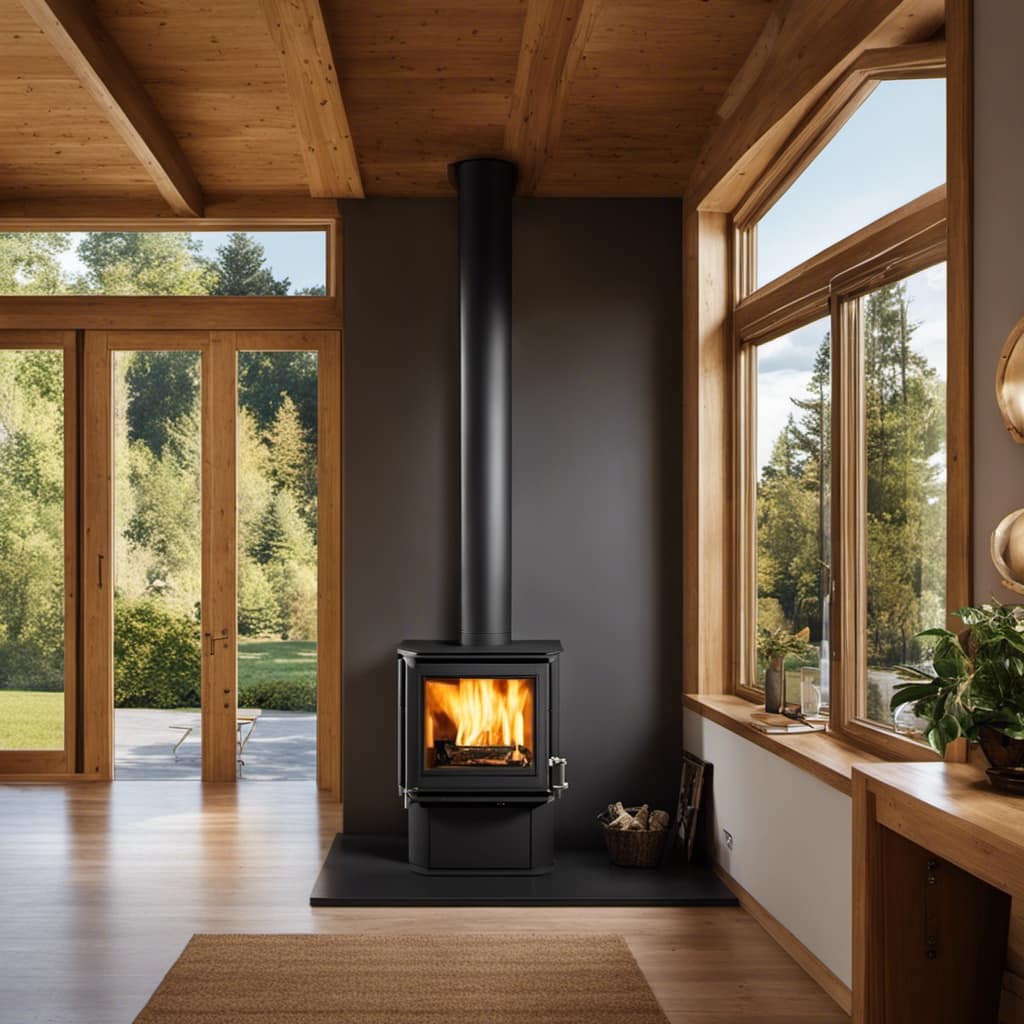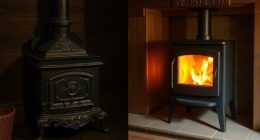As a seasoned user of wood stoves, I understand the significance of the way you stack your wood. The way you arrange it can greatly impact how efficiently your space is heated. It’s similar to solving a complex puzzle, where each piece must be placed just right in order to optimize performance and reduce smoke.

In this article, I’ll share my tried and true techniques for expertly stacking wood in a wood stove. From choosing the right wood to maintaining airflow, you’ll learn the secrets to a warm and smoke-free fire.
Let’s dive in!
Key Takeaways
- Different types of wood have different heat outputs.
- Split the wood into smaller pieces for better airflow during combustion.
- Seasoned firewood burns more efficiently and produces more heat.
- Proper stacking techniques greatly enhance the performance of a wood stove.
Choosing the Right Wood for Your Wood Stove
I find it important to choose the right wood for my wood stove. Different types of wood have different heat outputs, so it’s essential to select the right kind for your specific needs. Hardwoods like oak and maple burn longer and produce more heat, making them ideal for colder climates. Softwoods like pine and fir, on the other hand, burn faster and are better suited for milder weather or shorter burning periods.
When it comes to seasoning firewood, it’s crucial to ensure that the wood is dry and properly cured. Seasoned firewood burns more efficiently and produces more heat. By considering the type of wood and its seasoning, I can ensure optimal heat output and efficient burning in my wood stove.
Now, let’s move on to the next step: preparing the wood for stacking.
Preparing the Wood for Stacking
To ensure a successful fire, it’s important to properly arrange the logs in the wood stove. This starts with preparing the wood for stacking. Here are three key steps to follow:

-
Wood Splitting: Before stacking, it’s crucial to split the wood into smaller pieces. This makes it easier to handle and allows for better airflow during combustion. Use a sharp ax or a log splitter to safely split the wood along its grain.
-
Seasoning Wood: Freshly cut wood contains a high moisture content, which can make it difficult to burn efficiently. To combat this, the wood needs to be seasoned. This involves storing it in a dry, well-ventilated area for at least 6-12 months, allowing it to dry out and reach the optimal moisture level of around 20%.
-
Stacking Method: When stacking the wood in the stove, it’s important to create a stable and well-ventilated structure. Place larger logs at the bottom, forming a solid base. Then, layer smaller logs and kindling on top, ensuring there’s enough space between them for air circulation. This arrangement promotes better burning and helps maintain a consistent fire.
Proper Stacking Techniques for Maximum Efficiency
A stable and well-ventilated structure is essential for maximum efficiency when arranging the logs in the stove. Proper stacking techniques can greatly enhance the performance of your wood stove.
One of the most important factors to consider is using dry wood. Dry wood burns more efficiently and produces more heat compared to wet or green wood. It also reduces the amount of smoke and creosote buildup, which can lead to chimney fires.
Another benefit of using a wood stove for heating your home is that it’s a renewable and cost-effective source of heat. By utilizing wood as fuel, you can reduce your reliance on fossil fuels and lower your energy bills.
With the right stacking techniques and dry wood, your wood stove can provide a cozy and efficient heat source for your home.
Maintaining Airflow and Avoiding Smoke
Maintaining proper airflow is crucial for avoiding smoke and ensuring efficient combustion in my home heating system. Here are three important reasons why proper airflow is essential:
-
Efficient Combustion: Without proper airflow, the wood may not burn completely, resulting in smoke and wasted energy.
-
Avoiding Creosote Buildup: Insufficient airflow can lead to incomplete combustion, causing the release of unburned particles that can collect on the chimney walls as creosote. This buildup increases the risk of chimney fires.
-
Preventing Chimney Fires: When creosote accumulates in the chimney, it becomes highly flammable, increasing the likelihood of a dangerous chimney fire.

To maintain proper airflow, I ensure that the air vents in my wood stove are open and clean. Regular chimney inspections and cleanings are also crucial to prevent creosote buildup and reduce the risk of chimney fires.
Now, let’s move on to the next section about tips for properly storing wood for your wood stove.
Tips for Properly Storing Wood for Your Wood Stove
When storing firewood for my stove, I make sure to keep it off the ground and covered to protect it from moisture and pests. Proper wood storage is crucial for ensuring optimal burning and efficiency of your wood stove. Seasoning wood is the process of drying it out before use, which helps to reduce moisture content and improve its burnability. This can be achieved by splitting the wood and allowing it to dry for at least six months. Once the wood is properly seasoned, it should be stored in a well-ventilated area, preferably in a woodshed or covered with a tarp. This prevents moisture from seeping in and maintains the wood’s dryness. Additionally, storing wood off the ground helps to prevent pests and rot from affecting the quality of the wood.
| Seasoning Wood | Proper Wood Storage |
|---|---|
| Reduces moisture content | Keeps wood off the ground |
| Improves burnability | Covers wood to prevent moisture |
| Requires at least six months | Maintains wood’s dryness |
| Split wood for faster drying | Prevents pests and rot |
| Ensures optimal burning | Enhances wood stove efficiency |
Frequently Asked Questions
How Often Should I Clean My Wood Stove to Ensure Maximum Efficiency?
To ensure maximum efficiency, I clean my wood stove regularly. It’s important to remove ash and creosote buildup. Using seasoned wood also helps, as it burns more efficiently and produces less smoke.
Can I Stack Different Types of Wood Together in My Wood Stove?
Yes, you can stack different types of wood together in a wood stove. However, it’s important to consider the characteristics of each type, such as moisture content and burn rate, to ensure efficient and safe combustion.
What Are the Signs That Indicate My Wood Stove Is Not Getting Enough Airflow?
When a wood stove doesn’t have enough airflow, there are signs like smoke backing up into the room, difficulty in starting or maintaining a fire, and excessive creosote buildup. To improve airflow, make sure the air vents are open and clear.
Is It Necessary to Use a Wood Rack or Can I Stack Wood Directly on the Floor of the Stove?
It’s worth considering the benefits of using a wood rack, but there are alternative methods for stacking wood in a stove. Directly stacking wood on the floor can work, as long as there is proper airflow.
How Long Should I Let My Wood Dry Before Using It in the Wood Stove?
Before using wood in the stove, I let it dry for at least six months to ensure proper seasoning. This helps prevent excessive smoke and creosote buildup. Properly storing firewood and following tips for seasoning firewood are essential for optimal performance.

Conclusion
In conclusion, properly stacking wood in a wood stove is crucial for maximum efficiency and avoiding smoke. By choosing the right wood and preparing it correctly, you can ensure a steady heat output.
Using proper stacking techniques, such as the crisscross method, allows for better airflow and more complete combustion. Remember to maintain proper airflow and avoid overloading the stove to prevent smoke.
Lastly, storing wood properly ensures that it remains dry and ready to use.
Logan’s affair with adventure began in childhood. He hailed from a small town where vast forests bordered one side and endless shores stretched on the other. His days were spent exploring uncharted woods, climbing tall trees, or listening to the tales of old sailors. This early immersion in a world brimming with stories and mysteries became the foundation of his passion for writing.











